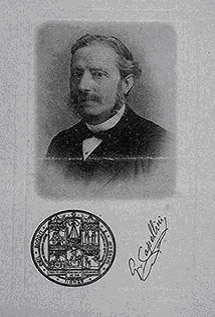Giovanni Capellini
Giovanni Capellini (1833- 1922)

1833
He was born in La Spezia and was forced to undertake an ecclesiastical career.
1854
To overcome initial financial constraints he carried out various jobs. As a tutor of a college in La Spezia he constructed various electrical machines with which he set up a good physics laboratory in his father’s house.
In his free time he went on excursions on the Mounts of Castellana, Coreana and Campiglia.
He was appointed Prefect by the Chancellor of the Seminar of Pontremoli and started studying geology.
After his father’s death he dedicated himself to studying natural sciences and definitely abandoned the ecclesiastical career, having received a bursary for his studies from the Municipality of La Spezia.
He enrolled as a student at the University of Pisa. He was encouraged by Giuseppe Meneghini whom he had started writing to with regards to the examination of some fossil collections.
1858
He graduated in Geology at Pisa and carried out surveys of Mount Pisano, Montagnola Senese, Castellina Marittima, Montecatini, Lagoni di Montecorboli, the Maritime Alps and the Gulf of La Spezia.
1858-59
He went to study in Paris where he attended lessons at the Ècole des Mines and the Jardin des Plantes establishing friendships with E. Lartet, A. Gaudry, W.S. Bayle and J. Barrande. He then moved to London.
1861
He was appointed Professor of Natural History at the Collegio Nazionale of Genoa.
On the same year the Minister for Public Education, T. Mamiani, called him to cover the chair of Geology at the University of Bologna. From this date he dedicated his entire life to geology and to directing the institute, where he established a high standard national and international management. The attached museum, that bears his name, is perhaps the most important institution that he promoted and certainly one of the richest and most important ones in Italy.
He was among the promoters of the Geological Map of Italy and was a member of the Geological Committee.
His inborn organizational skills matched with an excellent knowledge of foreign languages.
1862
He travelled to the United States of America (Nebraska, San Lorenzo river) and then to eastern Europe to continue his observation activities, to implement his collections and discoveries. His international contacts gave him a forefront position with respect to his times. Indeed, he was among the first to accept Charles Darwin’s theory on evolution.
1865
He organized the meeting of Italian naturalists in La Spezia.
1871
He organized the Archaeology and Anthropology Congress in Bologna.
1881
He organized and chaired the Geological Congress in Bologna, which was attended by specialists from all over the world and the results of which are still considered of fundamental importance especially for stratigraphical geology. On this occasion, the Geological Map of the Province of Bologna was drawn up as well as the Map of the Mounts of Livorno, the Map of Castellina Marittima (accompanied by ample explanatory notes) and the Geological Map of the Gulf of La Spezia was republished.
He actively participated to the foundation of Società Geologica Italiana together with Q. Sella and F. Giordano.
1888
He was for two times appointed Chancellor of the University of Bologna and Faculty Dean for various years. He promoted and organized the celebration of the 800th anniversary of the University of Bologna, inviting distinguished scholars from all over the world.
1889
He was appointed Chairman of the Geological Committee of Italy.
1907
He celebrated the 300th anniversary of the death of the Bolognese naturalist Aldrovandi, after having rearranged his vast collection of geological material putting it together into today’s Museo Aldovrandino.
He was nominated senator of the Kingdom of Italy.
1922
He died in Bologna.
He was awarded many both academic and honorary titles, decorations and awards both in Italy and abroad.
He wrote many publications, essays and monographs some of which are fundamental to study of the national territory. Of great importance are also his paleontological researches, a result of his explorations in the caves around La Spezia.
